|
(11) | EP 0 155 846 B1 |
| (12) | EUROPEAN PATENT SPECIFICATION |
|
|
| (54) |
A method of inhibiting corrosion in aqueous systems Verfahren zur Korrosionsinhibierung in wässrigen Systemen Procédé d'inhibition de la corrosion en milieu aqueux |
|
|
|||||||||||||||||||||||||||||||
|
||||||||||||||||||||||||||||||||
| Note: Within nine months from the publication of the mention of the grant of the European patent, any person may give notice to the European Patent Office of opposition to the European patent granted. Notice of opposition shall be filed in a written reasoned statement. It shall not be deemed to have been filed until the opposition fee has been paid. (Art. 99(1) European Patent Convention). |
[0001] This invention relates to the inhibition of corrosion in aqueous systems, especially in cooling water systems and their associated equipment.
[0002] A variety of different anions have been used to inhibit corrosion. These include phosphates, nitrites, chromates, phosphonates and molybdates. The effectiveness of the various anions is not, of course, the same and although many of them are reasonably effective they all possess one or more drawbacks.
[0003] In particular, the use of orthophosphate is well established. However, in order for the orthophosphate to be effective in the particular aqueous system, it is quite frequently necessary to use concentrations of orthophosphate greater than 10 ppm. However, the use of these higher concentrations of orthophosphate, in particular, makes it necessary to work in the presence of highly effective anionic dispersants in order to prevent calcium phosphate from fouling the heat exchangers and pipework in the system. The calcium phosphate suspended in the water in this way does not contribute towards corrosion inhibition and can, in fact, cause corrosion because if it is allowed to settle out on ferrous metal parts of the system corrosion can form underneath the resulting deposits and these are, of course, less accessible to the corrosion inhibitor.
[0004] Sodium nitrite is also well known as a corrosion inhibitor but it is normally necessary to use it in concentrations of 500-1000 ppm. At these levels the use of nitrite is environmentally unacceptable. Accordingly, therefore, it is not generally possible to use sodium nitrite in spite of its effectiveness.
[0005] It has now been found, according to the present invention, that the amounts of a corrosion controlling or inhibiting salt which is capable of forming a passivating or protective anodic film, namely an orthophosphate or nitrite, can be reduced significantly if they are used in combination with a cationic polymer. This passivating film is typically of gamma-ferric oxide. It has been found that a useful synergistic effect can be obtained with the result that a composition which is effective in rapidly forming a passivating film and subsequently inhibiting corrosion can be provided which contains much smaller amounts of the corrosion inhibiting salt. Accordingly, the present invention provides a method for inhibiting corrosion in an aqueous system which comprises adding to the system a corrosion inhibiting salt capable of forming a passivating film at the anode or anodic film which is an orthophosphate or nitrite and a protonated or quaternary ammonium cationic polymer which has a molecular weight from 400 to 10,000. The salts are typically water soluble salts, especially alkali metal, in particular sodium or potassium, salts. Ammonium salts are generally not to be recommended as they may promote attack on yellow metals such as copper or brass. The present invention has particular utility when used with orthophosphates such as disodium and trisodium orthophosphate. In general, by using the specified cationic polymers it is possible to use less than 10 ppm of orthophosphate and, indeed, amounts of say 5 ppm, orthophosphate together with a similar quantity of polymer is much more effective than the use of 10 ppm of orthophosphate by itself. Even though orthophosphates by themselves may not form a passivating anodic film at these low concentrations it is believed that such a film is formed when the polymer is present. In addition problems of pitting corrosion can be overcome. In contrast polyphosphates act by forming a film at the cathode and therefore are not suitable for use in the present invention.
[0006] The present invention is also applicable, as indicated, with water soluble inorganic nitrites, especially sodium nitrite; normally it is necessary to use 500 to 1000 ppm of sodium nitrite to be effective but such amounts are environmentally unacceptable By using the polymer in combination with the nitrite it is possible to reduce the concentration of the latter to, say, 45 ppm which is an environmentally acceptable level.
[0007] A considerable variety of different polymers having the required molecular weight can be used provided that they are cationic and either protonated or are quaternary ammonium polymers; preferably they are substantially linear i.e. polymers which have substantially no crosslinking but which may contain, for example, cyclic groups in a substantially linear chain. The quaternary ammonium polymers are preferably derived from ethylenically unsaturated monomers containing a quaternary ammonium group or are obtained by reaction between a polyalkylene polyamine and epichlorohydrin, or by reaction between epichlorhydrin, dimethylamine and either ethylene diamine or polyalkylene polyamine.
[0008] Typical cationic polymers which can be used in the present invention and which are derived from an ethylenically unsaturated monomer include homo- and co-polymers of vinyl compounds such as (a) vinyl pyridine and vinyl imidazole which may be quaternised with, say, a C₁ to C₁₈ alkyl halide, a benzyl halide, especially a chloride, or dimethyl or diethyl sulphate, or (b) vinyl benzyl chloride which may be quaternised with, say, a tertiary amine of formula NR₁R₂R₃ in which R₁ R₂ and R₃ are independently lower alkyl, typically of 1 to 4 carbon atoms, such that one of R₁ R₂ and R₃ can be C₁ to C₁₈ alkyl; allyl compounds such as diallyldimethyl ammonium chloride; or acrylic derivatives such as (i) a dialkyl aminomethyl(meth)acrylamide which may be quaternised with, say, a C₁ to C₁₈ alkyl halide, a benzyl halide or dimethyl or diethyl sulphate, (ii) a methacrylamido propyl tri(C₁ to C₄ alkyl, especially methyl) ammonium salt, or (iii) a (meth) acryloyloxyethyl tri(C₁ to C₄ alkyl, especially methyl) ammonium salt, said salt (ii) or (iii) being a halide, especially a chloride, methosulphate, ethosulphate or 1/n of an n-valent anion. These monomers may be copolymerised with a (meth)acrylic derivative such as acrylamide, an acrylate or methacrylate C₁-C₁₈ alkyl ester or acrylonitrile. Typical such polymers contain 10-100 mol % of recurring units of the formula:
and 0-90 mol % of recurring units of the formula:
in which R₁ represents hydrogen or a lower alkyl radical, typically of 1-4 carbon atoms, R₂ represents a long chain alkyl group, typically of 8 to 18 carbon atoms, R₃, R₄ and R₅ independently represent hydrogen or a lower alkyl group while X represents an anion,typically a halide ion, a methosulfate ion, an ethosulfate ion or 1/n of a n valent anion.
[0009] Other quaternary ammonium polymers derived from an unsaturated monomer include the homo-polymer of diallyldimethylammonium chloride which possesses recurring units of the formula:
In this respect, it should be noted that this polymer should be regarded as "substantially linear" since although it contains cyclic groupings these groupings are connected along a linear chain and there is no crosslinking.
[0010] Other polymers which can be used and which are derived from unsaturated monomers include those having the formula:
where Z and Z' which may be the same or different is -CH₂CH=CHCH₂- or -CH₂-CHOHCH₂-, Y and Y', which may be the same or different, are either X or -NH'R'', X is a halogen of atomic weight greater than 30, n is an integer of from 2 to 20, and R' and R'' (I) may be the same or different alkyl groups of from 1 to 18 carbon atoms optionally substituted by 1 to 2 hydroxyl groups; or (II) when taken together with N represent a saturated or unsaturated ring of from 5 to 7 atoms; or (III) when taken together with N and an oxygen atom represent the N-morpholino group, which are described in U.S. Patent US-A-4397743. A particularly preferred such polymer is poly(dimethylbutenyl) ammonium chloride bis-(triethanol ammonium chloride).
[0011] Another class of polymer which can be used and which is derived from ethylenically unsaturated monomers includes polybutadienes which have been reacted with a lower alkyl amine and some of the resulting dialkyl amino groups are quaternised. In general, therefore, the polymer will possess recurring units of the formula:
in the molar proportions a:b₁:b₂:c, respectively, where R represents a lower alkyl radical, typically a methyl or ethyl radical. It should be understood that the lower alkyl radicals need not all be the same. Typical quaternising agents include methyl chloride, dimethyl sulfate and diethyl sulfate. Varying ratios of a:b₁:b₂:c may be used with the amine amounts (b₁+b₂) being generally from 10-90% with (a+c) being from 90%-10%. These polymers can be obtained by reacting polybutadiene with carbon monoxide and hydrogen in the presence of an appropriate lower alkyl amine.
[0012] Of the quaternary ammonium polymers which are derived from epichlorohydrin and various amines, particular reference should be made to the polymers described in British Specification GB-A-2085433 and GB-A-1486396. A typical amine which can be employed is N,N,N',N'-tetramethylethylenediamine as well as ethylenediamine used together with dimethylamine and triethanolamine. Particularly preferred polymers of this type for use in the present invention are those having the formula:
where N is from O-500. although, of course, other amines can be employed.
Reference should be made to the above British Patent Specifications for further details.
[0013] Other polymers which can be used include protonated polymers such as polymers corresponding to the above quaternary ammonium polymers where the amine groups are not quaternised but are neutralised with acid, such as hydrochloric acid as well as cationic tannin derivatives, such as those obtained by a Mannich-type reaction of tannin (a condensed polyphenolic body) with formaldehyde and an amine, formed as a salt e.g. acetate, formate, hydrochloride. These cationic tannin derivatives can also be quaternised. Further polymers which can be used include the polyamine polymers which have been crosslinked such as polyamideamine/polyethylene polyamine copolymers crosslinked with, say, epichlorohydrin.
[0014] The amounts of the components used do, of course, depend, to some extent, on the severity of the corrosion conditions but, of course, corrosion inhibiting amounts are desirable. In general, however, from 1-50 ppm, especially from 3-10 ppm, of each will be used and the relative amounts of the two components will generally vary from 1:10 to 10:1 by weight, especially with the polymer concentration being at least as great as that of the salt.
[0015] Although the components can be added to the system separately it will generally be more convenient to add them together as a single composition. Accordingly, the present invention also provides a composition suitable for addition to an aqueous system which comprises a protonated or quaternary ammonium cationic polymer which has a molecular weight of 400 to 10,000 and a water soluble corrosion inhibiting salt which is capable of forming a passivating anodic film which is an orthophosphate or nitrite.
[0016] The compositions of the present invention will normally be in the form of an aqueous solution containing, in general, from 1-25% by weight active ingredient (solids). A common concentration is from 5-10% by weight.
[0017] The additives used in the present invention can be used, sometimes advantageously, together with other water treatment additives such as phosphonates which do not act anodically such as pentaphosphonomethylene substituted diethylenetriamine, dispersants such as sulphonated and carboxylated polymers, especially copolymers of maleic acid and sulphonated styrene or of methacrylic acid and 2-acrylamido-2-methyl propane sulphonic acid azoles such as benzotriazole and biocides such as isothiazolones, methylene bis (thiocyanate), quaternary ammonium compounds and chlorine release agents. In fact certain of the cationic polymers possess biocidal properties thereby enhancing the effect of the biocides.
Examples 1-6
[0019] These examples were carried out on a laboratory recirculating rig using a synthetic water possessing 80 ppm calcium hardness, 25 ppm magnesium hardness and 100 ppm "M" alkalinity and pH of 8.6. The temperature of the water was maintained at 130°F (54,4°C) and the rig was first passivated for one day at three times the normal dose level to form a passivating film. The test lasted three days using a flow rate of 2 ft. (0.61 m) per second in line and 0.2 ft (0,06 cm) per second in the tank. Mild steel test coupons were placed in the line and in the tank, corrosion rates being calculated from the weight loss of the coupons during the experiment.
[0020] In this test, the additives were orthophosphate in the form of disodium hydrogen phosphate and a cationic polymer (denoted as polymer A) which was a quaternary ammonium compound formed from epichlorohydrin, ethylenediamine, dimethylamine and triethanolamine obtained according to the procedure described in British specification GB-A-2085433, having molecular weight of 5,000-6,000. The results obtained are shown in the following table:
| Example No. | Additive | Dose ppm | Corrosion rate, mils. per year (mm per year) | |
| Mild Steel (Line) | Mild Steel (Tank) | |||
| 1 | Orthophosphate/Polymer A | 10/10 | 0.8(0.02) | 0.7(0.02) |
| 2 | Orthophosphate | 10 | 18.4(0.46) | 14.3(0.36) |
| 3 | Polymer A | 10 | 58.1(1.45) | 73.8(1.85) |
| 4 | Orthophosphate | 5 | 25.4(0.64) | 16.7(0.42) |
| 5 | Polymer A | 5 | 48.9(1.22) | 56.2(1.41) |
| 6 | Polymer A/Orthophosphate | 5/5 | 1.9(0.05) | 1.5(0.04) |
[0021] These Examples demonstrate the synergistic effect obtained using polymer A in conjunction with the orthophosphate in the prevention of corrosion of mild steel.
Examples 7-12
[0023] Polymer B was a copolymer of lauryl methacrylate and methacryloyloxyethyl trimethylammonium metho sulfate (mol ratio 40:60) having a molecular weight of 5,000 while polymer C was a homopolymer of diallyldimethylammonium chloride having a molecular weight of 4,000-5,000. The results obtained are shown in the following table.
| Example No. | Additive | Dose ppm | Corrosion rate, mils.per year (mm per year) | |
| Mild Steel (Line) | Mild Steel (Tank) | |||
| 7 | Polymer B/Orthophosphate | 5/5 | 0.5(0.01) | 0.4(0.01) |
| 8 | Polymer B/ - | 10/- | 88.8(2.22) | 53.3(1.33) |
| 9 | Polymer C/Orthophosphate | 5/5 | 1.0(0.03) | 1.1(0.03) |
| 10 | Polymer C/ - | 10/- | 63.7(1.60) | 41.0(1.03) |
| 11 | - /Orthophosphate | -/10 | 18.4(0.46) | 14.3(0.36) |
| 12 | No Additive | - | 43.2(1.08) | 45.7(1.14) |
It is clear from these results that the cationic polymers are not in themselves corrosion inhibitors but act synergistically with the orthophosphate.
Examples 13-17
[0024] The test procedure used in Examples 1-6 was repeated but varying the ratios of the cationic polymers to orthophosphate. By way of comparison sodium hexametaphosphate was used. The results obtained are shown in the following table:
Examples 18-20
[0025] These examples demonstrate that the combination of the present invention can be employed in an aqueous system in the presence of other additives where interaction with the additive might have been expected.
[0026] The test procedure used in the preceding Examples was followed. The results obtained are shown in the following table:
| Example No. | Additive | Dose, ppm | Corrosion Rate, mils.per year (mm per year) | |
| Mild Steel (Line) | Mild Steel (Tank) | |||
| 18 | Polymer A/orthophosphate/Polymer D/phosphonate A | 3/5/5/5 | 1.5(0.04) | 1.4(0.04) |
| 19 | Polymer A/orthophosphate/Polymer D/phosphonate A | 5/5/5/5 | 1.1(0.03) | 1.3(0.03) |
| 20 | Polymer A/orthophosphate/Polymer E/phosphate A | 5/5/3/5 | 1.3(0.03) | 1.2(0.03) |
| Polymer D = Copolymer of Acrylic acid/hydroxypropylacrylate (mole ratio 3:1, molecular
weight 6000). Polymer E = Copolymer of methacrylic acid/2 acrylamido 2 methyl propane sulphonic acid (mole ratio 1:1, molecular weight 5000). Phosphonate A = 2-Phosphonobutane-1,2,4-tricarboxylic acid. |
||||
Examples 21-23
[0027] The same test procedure was employed using the ingredients specified in the following table which gives the results obtained:
| Example No. | Additive | Dose ppm | Corrision Rate mils. per year (mm per year) | |
| Mild Steel (Line) | Mild Steel (Tank) | |||
| C | Polymer A/Sodium Hexametaphosphate | 10/10 | 2.7(0.07) | 3.7(0.09) |
| 21 | Polymer A/orthophosphate | 10/10 | 0.08(0.02) | 0.7(0.02) |
| 22 | Phosphonate A/Polymer F/ Orthophosphate | 6/2.5/3 | 1.6(0.04) | 1.9(0.05) |
| (Pitting corrosion evident) | ||||
| 23 | Phosphonate A/Polymer A/ Orthophosphate | 6/2.5/3 | 0.8(0.02) | 1.3(0.03) |
| (No pitting corrosion) | ||||
| Polymer F = polymethacrylic acid of molecular weight 5,400. All phosphate concentrations are calculated as PO₄. |
||||
[0028] It is clear from Examples C and 22 that the present invention is more effective than a combination of the same polymer and a polyphosphate.
[0029] Examples 22 and 23 illustrate the fact that the presence of the cationic polymer inhibits pitting corrosion when small concentrations of orthophosphate are employed.
Examples 24-25
[0030] These Examples illustrate the effectiveness of 2 further cationic polymers in the presence of orthophosphate. The same test procedure was used.
| Example No. | Additive | Dose ppm | Corrosion Rate, mils. per year (mm per year) | |
| Mild Steel (Line) | Mild Steel (Tank) | |||
| 24 | Polymer G/Orthophosphate | 10/10 | 0.8(0.02) | 0.6(0.02) |
| 25 | Polymer H/Orthophosphate | 5/5 | 1.8(0.05) | 3.6(0.09) |
| Polymer G = Aminomethylated polybutadiene, molecular weight 1300, with a medium degree
of amine incorporation. Polymer H = Aminomethylated polybutadiene, molecular weight 2000, with high amine incorporation. |
||||
Examples 26-30
[0031] These Examples illustrate the effectiveness of the cationic polymers when used with sodium nitrite at a much lower concentration than that usually employed while obtaining acceptable corrosion rates.
| Test: Conditions as in Examples 1-25 | ||||
| Example No. | Additive | Dose ppm | Corrosion Rate, mils.per year (mm per year) | |
| Mild Steel (Line) | Mild Steel (Tank) | |||
| 26 | Polymer A/Sodium Nitrite | 10/45 | 2.3(0.06) | 2.6(0.07) |
| 27 | Polymer A/Sodium Nitrite | 7.5/45 | 3.2(0.08) | 4.4(0.11) |
| 28 | Polymer A/Sodium Nitrite | 5/45 | 9.1(0.23) | 11.2(0.28) |
| 29 | Polymer A/Sodium Nitrite | 3/45 | 12.4(0.31) | 11.3(0.28) |
| 30 | Polymer A/Sodium Nitrite | /45 | 15.7(0.39) | 34.8(0.87) |
Examples 31-32
[0032] These Examples demonstrate the effectiveness of further types of cationic polymer in combination with a salt capable of forming an anodic passivating film.
| Example No. | Additive | Dose ppm | Corrosion Rate, mils.per year (mm per year) | |
| Mild Steel (Line) | Mild Steel (Tank) | |||
| 31 | Cationic Tannin/o-phosphate | 10/10 | 1.5(0.04) | 2.3(0.06) |
| 32 | Cross-linked Polyamideamine - polyethylene polyamine co-polymer/o-phosphate | 5/5 | 1.0(0.03) | 1.0(0.03) |
Examples 33-34
[0033] The following Examples illustrate the ability of the cationic polymer to enable one to use very small amounts of corrosion inhibiting salt. The results obtained are shown in the following table:
| Example No. | Additives | Dose, ppm | Corrosion Rate, mils.per year | |
| Mild Steel (Line) | Mild Steel (Tank) | |||
| 33 | Polymer A/Orthophosphate | 10/3 | 2.2(0.06) | 2.4(0.06) |
| 34 | Polymer A/Orthophosphate | 10/1.5 | 3.5(0.09) | 4.8(0.12) |
1. A method for inhibiting corrosion in an aqueous system characterized by adding to
the system at least one corrosion inhibiting salt capable of forming a passivating
film at the anode which is an orthophosphate or nitrite, and a protonated or quaternary
ammonium cationic polymer having a molecular weight from 400 to 10,000.
2. A method according to claim 1 in which the salt is an alkali metal salt.
3. A method according to claim 1 or 2 in which the salt is disodium or trisodium orthophosphate
or sodium nitrite.
4. A method according to any one of the preceding claims in which the polymer is substantially
linear.
5. A method according to any one of claims 1 to 4 in which the polymer is one derived
from an ethylenically unsaturated monomer containing a quaternary ammonium group or
one obtained by a reaction between a polyalkylene polyamine and epichlorohydrin or
by reaction between epichlorohydrin, dimethylamine and ethylene diamine or a polyalkylene
polyamine.
6. A method according to any one of claims 1 to 4 in which the cationic polymer is derived
from vinyl pyridine or vinyl imidazole or an acrylic derivative, quaternised with
C₁ to C₁₈ alkyl halide, or a benzyl halide, or dimethyl or diethyl sulphate, a vinyl
benzyl chloride quaternised with a tertiary amine or an allyl compound.
7. A method according to any one of claim 1 to 4 in which the cationic polymer contains
10 to 100 mol % of recurring units of the formula:

and 0-90 mol % of recurring units of the formula:

in which R₁ represents hydrogen or a lower alkyl radical, R₂ represents a long chain alkyl group, R₃, R₄ and R₅ independently represent hydrogen or a lower alkyl group while X represents an anion.
and 0-90 mol % of recurring units of the formula:
in which R₁ represents hydrogen or a lower alkyl radical, R₂ represents a long chain alkyl group, R₃, R₄ and R₅ independently represent hydrogen or a lower alkyl group while X represents an anion.
8. A method according to any one of claims 1 to 4 in which the polymer possesses recurring
units of the formula:

9. A method according to any one of claims 1 to 4 in which the cationic polymer is derived
from an unsaturated polymer having the formula:

where Z and Z' which may be the same or different is -CH₂CH=CHCH₂- or -CH₂-CHOHCH₂-, Y and Y', which may be the same or different, are either x or -NH'R'', X is a halogen of atomic weight greater than 30, n is an integer of from 2 to 20, and R' and R'' (I) may be the same or different alkyl groups of from 1 to 18 carbon atoms optionally substituted by 1 to 2 hydroxyl groups; or (II) when taken together with N represent a saturated or unsaturated ring of from 5 to 7 atoms; or (III) when taken together with N and an oxygen atom represent the N-morpholino group.
where Z and Z' which may be the same or different is -CH₂CH=CHCH₂- or -CH₂-CHOHCH₂-, Y and Y', which may be the same or different, are either x or -NH'R'', X is a halogen of atomic weight greater than 30, n is an integer of from 2 to 20, and R' and R'' (I) may be the same or different alkyl groups of from 1 to 18 carbon atoms optionally substituted by 1 to 2 hydroxyl groups; or (II) when taken together with N represent a saturated or unsaturated ring of from 5 to 7 atoms; or (III) when taken together with N and an oxygen atom represent the N-morpholino group.
10. A method according to any one of claims 1 to 4 in which the cationic polymer is poly(dimethylbutenyl)
ammonium chloride bis-(triethanol ammonium chloride).
11. A method according to any one of claims 1 to 4 in which the cationic polymer possesses
recurring units of the formula:

where R represents a lower alkyl radical.
where R represents a lower alkyl radical.
12. A method according to any one of claims 1 to 4 in which the cationic polymer has the
formula:

where N is from 0-500.
where N is from 0-500.
13. A method according to any one of claims 1 to 4 in which the cationic polymer is a
cationic tannin derivative obtained by reaction of tannin with formaldehyde and an
amine.
14. A method according to any one of the preceding claims in which the cationic polymer
and salts are each present in an amount from 1 to 50 ppm.
15. A method according to claim 14 in which the cationic polymer and salts are each present
in an amount from 3 to 10 ppm.
16. A method according to any one of the preceding claims in which the relative amount
of the polymer and salt is from 1:10 to 10:1 by weight.
17. A method according to any one of the preceding claims in which the concentration of
polymer is at least as great as that of the salt.
18. A method according to any one of the preceding claims in which the aqueous system
is a cooling system.
19. A composition suitable for addition to an aqueous system characterized by comprising
a protonated or quaternary ammonium cationic polymer having a molecular weight from
400 to 10,000 and at least one water soluble corrosion inhibiting salt which is capable
of forming a passivating film at the anode which is an orthophosphate or nitrite.
20. A composition according to claim 19 which is in the form of an aqueous solution.
21. A composition according to claim 19 or 20 in which the active ingredients (solid)
are present in an amount from 1 to 25 % by weight.
22. A composition according to any one of claims 19 to 21 in which the salt is not an
ammonium salt.
23. A composition according to any one of claims 19 to 22 in which the salt is an alkali
metal salt.
24. A composition according to any one of claims 19 to 23 in which the salt is disodium
or trisodium orthophosphate or sodium nitrite.
25. A composition according to any one of claims 19 to 24 in which the polymer is substantially
linear.
26. A composition according to any one of claims 19 to 25 in which the polymer is one
derived from an ethylenically unsaturated monomer containing a quaternary ammonium
group or one obtained by a reaction between a polyalkylene and epichlorohydrin or
by reaction between epichlorohydrin, dimethylamine or ethylene diamine or a polyalkylene
polyamine.
27. A composition according to any one of claims 19 to 25 in which the cationic polymer
is derived from vinyl pyridine or vinyl imidazole or an acrylic derivative quaternised
with C₁ to C₁₈ alkyl halide, or a benzyl halide, or dimethyl or diethyl sulphate,
a vinyl benzyl chloride quaternised with a tertiary amine or an allyl compound.
28. A composition according to any one of claims 19 to 25 in which the cationic polymer
contains 10 to 100 mol % of recurring units of the formula:

and 0-90 mol % of recurring units of the formula:

in which R₁ represents hydrogen or a lower alkyl radical, R₂ represents a long chain alkyl group, R₃, R₄ and R₅ independently represent hydrogen or a lower alkyl group while X represents an anion.
and 0-90 mol % of recurring units of the formula:
in which R₁ represents hydrogen or a lower alkyl radical, R₂ represents a long chain alkyl group, R₃, R₄ and R₅ independently represent hydrogen or a lower alkyl group while X represents an anion.
29. A composition according to any one of claims 19 to 25 in which the polymer possesses
recurring units of the formula:

30. A composition according to any one of claims 19 to 25 in which the cationic polymer
is derived from an unsaturated polymer having the formula:

where Z and Z' which may be the same or different is -CH₂CH=CHCH₂- or -CH₂-CHOHCH₂-, Y and Y', which may be the same or different, are either X or -NH'R'', X is a halogen of atomic weight greater than 30, n is an integer of from 2 to 20, and R' and R'' (I) may be the same or different alkyl groups of from 1 to 18 carbon atoms optionally substituted by 1 or 2 hydroxyl groups; or (II) when taken together with N represent a saturated or unsaturated ring of from 5 to 7 atoms; or (III) when taken together with N and an oxygen atom represent the N-morpholino group.
where Z and Z' which may be the same or different is -CH₂CH=CHCH₂- or -CH₂-CHOHCH₂-, Y and Y', which may be the same or different, are either X or -NH'R'', X is a halogen of atomic weight greater than 30, n is an integer of from 2 to 20, and R' and R'' (I) may be the same or different alkyl groups of from 1 to 18 carbon atoms optionally substituted by 1 or 2 hydroxyl groups; or (II) when taken together with N represent a saturated or unsaturated ring of from 5 to 7 atoms; or (III) when taken together with N and an oxygen atom represent the N-morpholino group.
31. A composition according to any one of claims 19 to 25 in which the cationic polymer
is poly(dimethylbutenyl) ammonium chloride bis-(triethanol ammonium chloride).
32. A composition according to any one of claims 19 to 25 which the cationic polymer possesses
recurring units of the formula:

in the molar proportions a:b₁:b₂:c, respectively, where R represents a lower alkyl radical.
in the molar proportions a:b₁:b₂:c, respectively, where R represents a lower alkyl radical.
33. A composition according to any one of claims 19 to 25 in which the cationic polymer
has the formula:

where N is from 0-500.
where N is from 0-500.
34. A composition according to any one of claims 19 to 25 in which the cationic polymer
is a cationic tannin derivative obtained by reaction of tannin with formaldehyde and
an amine.
35. A composition according to any one of claims 19 to 34 in which the relative amounts
of the two components is from 1:10 to 10:1 by weight.
36. A composition according to any one of claims 19 to 35 in which the concentration of
polymer is at least as great as that of the salt.
37. A composition according to any one of claims 19 to 36 which also contains a phosphonate
which does not act anodically, a dispersant, an azole, or a biocide.
38. A composition according to claim 37 in which the said phosphonate is pentaphosphonomethylene
substituted diethylenetriamine, the dispersant is a copolymer of maleic acid and sulphonated
styrene or of methacrylic acid and 2-acrylamido-2-methylpropane sulphonic acid, the
azole is benzotriazole and the biocide is an isothiazolone, methylene bis(thiocyanate),
a quaternary ammonium compound or a chlorine release agent.
1. Procédé d'inhibition de la corrosion dans un système aqueux, caractérisé par l'addition,
au système, d'au moins un sel inhibant la corrosion, capable de former un film de
passivation à l'anode, qui est un orthophosphate ou un nitrite et un polymère cationique
d'ammonium quaternaire ou protoné ayant un poids moléculaire de 400 à 10.000.
2. Procédé selon la revendication 1, où le sel est un sel d'un métal alcalin.
3. Procédé selon la revendication 1 ou 2, où le sel est l'orthophosphate disodique ou
trisodique ou le nitrite de sodium.
4. Procédé selon l'une quelconque des revendications précédentes, où le polymère est
sensiblement linéaire.
5. Procédé selon l'une quelconque des revendications 1 à 4, où le polymère est dérivé
d'un monomère à insaturation éthylénique contenant un groupe ammonium quaternaire
obtenu par une réaction entre une polyalkylène polyamine et l'épichlorohydrine ou
par réaction entre l'épichlorohydrine, la diméthylamine et l'éthylènediamine ou une
polyalkylène polyamine.
6. Procédé selon l'une quelconque des revendications 1 à 4, où le polymère cationique
est dérivé de vinyl pyridine ou de vinyl imidazole ou d'un dérivé acrylique, quaternisé
avec un halogénure d'alkyle C₁ à C₁₈ ou bien un halogénure de benzyle ou un diméthyl
ou diéthyl sulfate, un chlorure de vinyl benzyle quaternisé avec une amine tertiaire
ou un composé allylique.
7. Procédé selon l'une quelconque des revendications 1 à 4, où le polymère cationique
contient 10 à 100 moles% d'unités récurrentes de la formule :

et 0-90 moles% d'unités récurrentes de la formule :
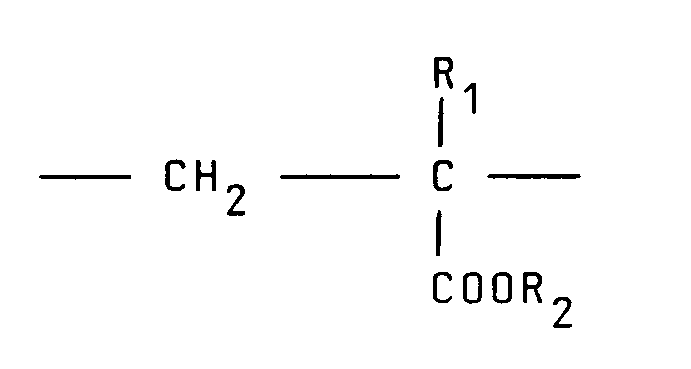
où R₁ représente hydrogène ou un radical alkyle inférieur, R₂ représente un groupe alkyle à chaîne longue, R₃, R₄ et R₅ représentent indépendamment hydrogène ou un groupe alkyle inférieur tandis que X représente un anion.
et 0-90 moles% d'unités récurrentes de la formule :
où R₁ représente hydrogène ou un radical alkyle inférieur, R₂ représente un groupe alkyle à chaîne longue, R₃, R₄ et R₅ représentent indépendamment hydrogène ou un groupe alkyle inférieur tandis que X représente un anion.
8. Procédé selon l'une quelconque des revendications 1 à 4, où le polymère possède des
unités récurrentes de la formule :

9. Procédé selon l'une quelconque des revendications 1 à 4, où le polymère cationique
est dérivé d'un polymère insaturé ayant pour formule
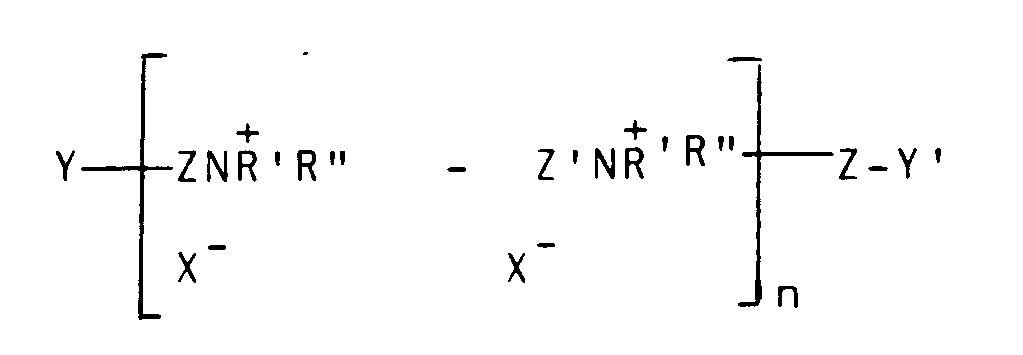
où Z et Z',qui peuvent être identiques ou différents, est -CH₂CH=CHCH₂- ou -CH₂-CHOHCH₂-, Y et Y', qui peuvent être identiques ou différents, sont soit X ou-NH' R'', X est un halogène d'un poids atomique supérieur à 30, n est un nombre entier de 2 à 20 et R' et R'' (I) peuvent être des groupes alkyles identiques ou différents de 1 à 18 atomes de carbone, facultativement substitués par 1 à 2 groupes hydroxyles ; ou bien (II), lorsqu'ils sont pris ensemble avec N, ils représentent un noyau saturé ou insaturé de 5 à 7 atomes ; ou bien (III), lorsqu'ils sont pris ensemble avec N et un atome d'oxygène, ils représentent le groupe N-morpholino.
où Z et Z',qui peuvent être identiques ou différents, est -CH₂CH=CHCH₂- ou -CH₂-CHOHCH₂-, Y et Y', qui peuvent être identiques ou différents, sont soit X ou-NH' R'', X est un halogène d'un poids atomique supérieur à 30, n est un nombre entier de 2 à 20 et R' et R'' (I) peuvent être des groupes alkyles identiques ou différents de 1 à 18 atomes de carbone, facultativement substitués par 1 à 2 groupes hydroxyles ; ou bien (II), lorsqu'ils sont pris ensemble avec N, ils représentent un noyau saturé ou insaturé de 5 à 7 atomes ; ou bien (III), lorsqu'ils sont pris ensemble avec N et un atome d'oxygène, ils représentent le groupe N-morpholino.
10. Procédé selon l'une quelconque des revendications 1 à 4, où le polymère cationique
est le chlorure de poly(diméthylbutényl)ammonium bis-(chlorure de triéthanol ammonium).
11. Procédé selon l'une quelconque des revendications 1 à 4, où le polymère cationique
possède des unités récurrentes de la formule :

où R représente un radical alkyle inférieur.
où R représente un radical alkyle inférieur.
12. Procédé selon l'une quelconque des revendications 1 à 4, où le polymère cationique
a pour formule :

où N est compris entre 0 et 500.
où N est compris entre 0 et 500.
13. Procédé selon l'une quelconque des revendications 1 à 4, où le polymère cationique
est un dérivé cationique de tanin obtenu par réaction de tanin avec du formaldéhyde
et une amine.
14. Procédé selon l'une quelconque des revendications précédentes, où le polymère cationique
et les sels sont présents en une quantité de 1 à 50 ppm.
15. procédé selon la revendication 14, où le polymère cationique et les sels sont présents
en une quantité de 3 à 10 ppm.
16. Procédé selon l'une quelconque des revendications précédentes, où la quantité relative
du polymère et du sel est de 1:10 à 10:1 en poids.
17. Procédé selon l'une quelconque des revendications précédentes, où la concentration
du polymère est au moins aussi importante que celle du sel.
18. Procédé selon l'une quelconque des revendications précédentes, où le système aqueux
est un système de refroidissement.
19. Composition appropriée à l'addition à un système aqueux, caractérisée en ce qu elle
comprend un polymère cationique d'ammonium quaternaire ou protoné ayant un poids moléculaire
de 400 à 10.000 et au moins un sel soluble dans l'eau, inhibant la corrosion, qui
est capable de former un film de passivation sur l'anode, qui est un orthophosphate
ou un nitrite.
20. Composition selon la revendication 19 qui a la forme d'une solution aqueuse.
21. Composition selon la revendication 19 ou 20 dans laquelle les ingrédients actifs (solides)
sont présents en une quantité de 1 à 25% en poids.
22. Composition selon l'une quelconque des revendications 19 à 21, où le sel n'est pas
un sel d'ammonium.
23. Composition selon l'une quelconque des revendications 19 à 22, où le sel est un sel
d'un métal alcalin.
24. Composition selon l'une quelconque des revendications 19 à 23, où le sel est l'orthophosphate
disodique ou trisodique ou le nitrite de sodium.
25. Composition selon l'une quelconque des revendications 19 à 24, où le polymère est
sensiblement linéaire.
26. Composition selon l'une quelconque des revendications 19 à 25, où le polymère est
dérivé d'un monomère à insaturation éthylénique contenant un groupe ammonium quaternaire
ou bien un obtenu par une réaction entre un polyalkylène et une épichlorohydrine ou
par réaction entre l'épichlorohydrine, la diméthylamine ou l'éthylène diamine ou bien
une polyalkylène polyamine.
27. Composition selon l'une quelconque des revendications 19 à 25, où le polymère cationique
est dérivé de vinyl pyridine ou de vinyl amidazole ou d'un dérivé acrylique quaternisé
avec un halogénure d'alkyle C₁ à C₁₈ ou bien un halogénure ce benzyle ou bien un diméthyl
ou diéthyl sulfate, un chlorure de vinyl benzyle quaternisé par une amine tertiaire
ou un composé allylique.
28. Composition selon l'une quelconque des revendications 19 à 25 où le polymère cationique
contient 10 à 100 moles% d'unités récurrentes de la formule :

et 0-90moles% d'unités récurrentes de la formule :
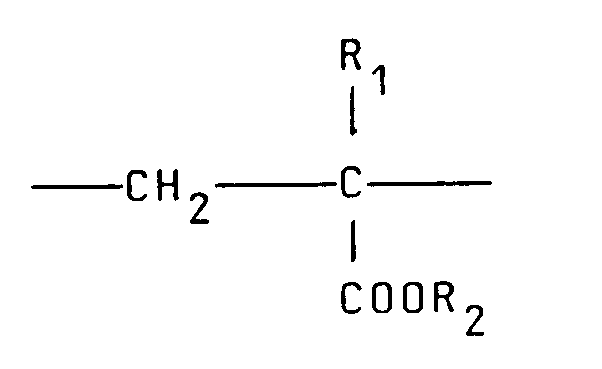
où R₁ représente hydrogène ou un radical alkyle inférieur, R₂ représente un groupe alkyle à chaîne longue, R₃, R₄ et R₅ représentent indépendamment hydrogène ou un groupe alkyle inférieur tandis que X représente un anion.
et 0-90moles% d'unités récurrentes de la formule :
où R₁ représente hydrogène ou un radical alkyle inférieur, R₂ représente un groupe alkyle à chaîne longue, R₃, R₄ et R₅ représentent indépendamment hydrogène ou un groupe alkyle inférieur tandis que X représente un anion.
29. Composition selon l'une quelconque des revendications 19 à 25, où le polymère possède
des unités récurrentes de la formule ;
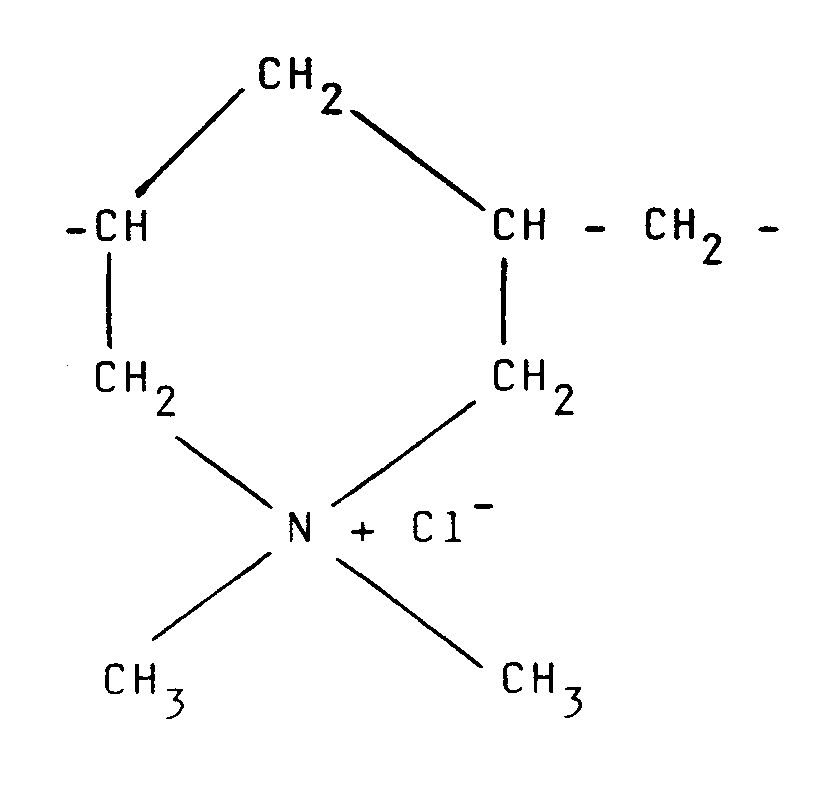
30. Composition selon l'une quelconque des revendications 19 à 25, où le polymère cationique
est dérivé d'un polymère insaturé ayant pour formule :
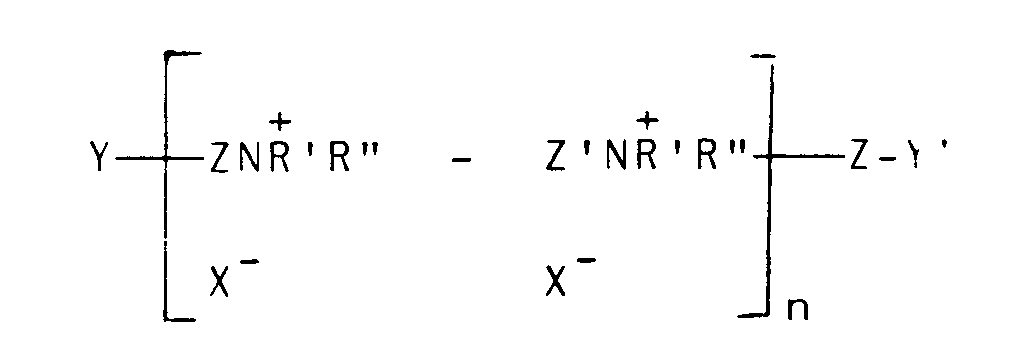
où Z et Z', qui peuvent être identiques ou différents, sont -CH₂CH=CHCH₂- ou -CH₂-CHOHCH₂- . Y et Y', qui peuvent être identiques ou différents, sont soit X ou -NH'R'', X est un halogène d'un poids atomique supérieur à 30, n est un nombre entier de 2 à 20, et R' et R'' (I) peuvent être des groupes alkyles identiques ou différents de 1 à 18 atomes de carbone, facultativement substitués par 1 ou 2 groupes hydroxyles ; ou (II), lorsqu'ils sont pris ensemble avec N, représentent un noyau saturé ou insaturé de 5 à 7 atomes ; ou bien (III), lorsqu'ils sont pris ensemble avec N et un atome d'oxygène, représentent le groupe N-morpholino.
où Z et Z', qui peuvent être identiques ou différents, sont -CH₂CH=CHCH₂- ou -CH₂-CHOHCH₂- . Y et Y', qui peuvent être identiques ou différents, sont soit X ou -NH'R'', X est un halogène d'un poids atomique supérieur à 30, n est un nombre entier de 2 à 20, et R' et R'' (I) peuvent être des groupes alkyles identiques ou différents de 1 à 18 atomes de carbone, facultativement substitués par 1 ou 2 groupes hydroxyles ; ou (II), lorsqu'ils sont pris ensemble avec N, représentent un noyau saturé ou insaturé de 5 à 7 atomes ; ou bien (III), lorsqu'ils sont pris ensemble avec N et un atome d'oxygène, représentent le groupe N-morpholino.
31. Composition selon l'une quelconque des revendications 19 à 25, où le polymère cationique
est chlorure de poly(diméthylbutényl)ammonium bis(chlorure de triéthanol ammonium).
32. Composition selon l'une quelconque des revendications 19 à 25, où le polymère cationique
possède des unités récurrentes de la formule :
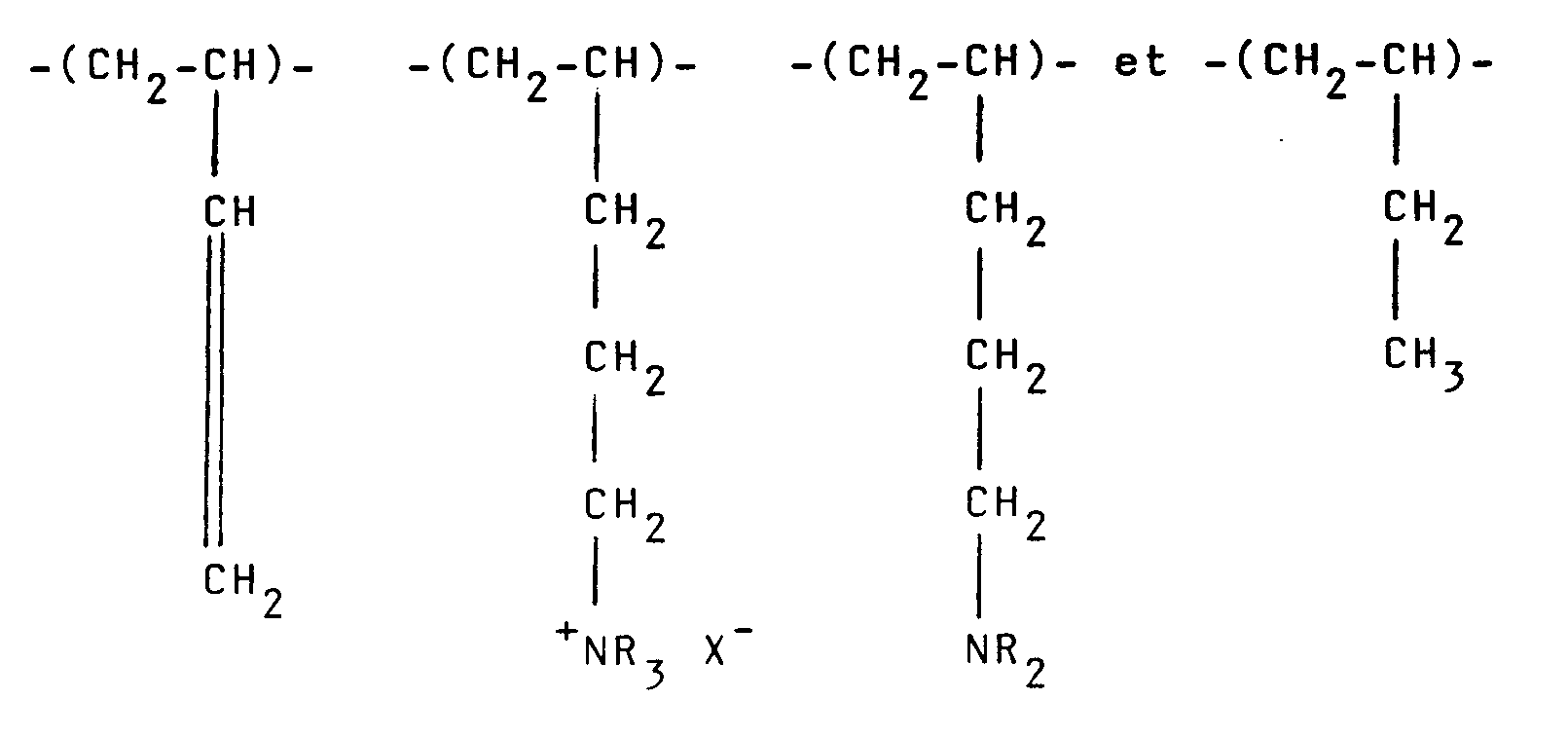
aux proportions molaires de a:b₁:b₂:c, respectivement, où R représente un radical alkyle inférieur.
aux proportions molaires de a:b₁:b₂:c, respectivement, où R représente un radical alkyle inférieur.
33. Composition selon l'une quelconque des revendications 19 à 25, où le polymère cationique
a pour

formule : où N est compris entre 0 et 500.
formule : où N est compris entre 0 et 500.
34. Composition selon l'une quelconque des revendications 19 à 25, où le polymère cationique
est un dérivé cationique de tanin obtenu par réaction de tanin avec du formaldéhyde
et une amine.
35. Composition selon l'une quelconque des revendications 19 à 34, où les quantités relatives
des deux composants sont de 1:10 à 10:1 en poids.
36. Composition selon l'une quelconque des revendications 19 à 35, où la concentration
du polymère est au moins aussi importante que celle du sel.
37. Composition selon l'une quelconque des revendications 19 à 36, qui contient également
un phosphonate qui n'agit pas anodiquement, un dispersant, un azole ou un biocide.
38. Composition selon la revendication 37, où ledit phosphonate est la diéthylènetriamine
pentaphosphonométhylène substituée, le dispersant est un copolymère d'acide maléique
et de styrène sulfoné ou d'acide méthacrylique et d'acide 2-acrylamido-2-méthylpropane
sulfonique, l'azole est le benzotriazole et le biocide est une isothiazolone, le méthylène
bis(thiocyanate), un composé d'ammonium quaternaire ou un agent de libération du chlore.
1. Verfahren zur Korrosionsverhinderung in einem wäßrigen System, dadurch gekennzeichnet, daß dem System mindestens ein korrosionsverhinderndes Salz, das in der Lage ist,
einen passivierenden Film auf der Anode zu bilden, und bei dem es sich um ein Orthophosphat
oder Nitrit handelt, und ein protoniertes oder quaternäres Ammonium-kationisches Polymer
mit einem Molekulargewicht von 400 bis 10 000 zugesetzt werden.
2. Verfahren nach Anspruch 1, bei dem das Salz ein Alkalimetallsalz ist.
3. Verfahren nach einem der Ansprüche 1 oder 2, bei dem das Salz Dinatrium- oder Trinatriumorthophosphat
oder Natriumnitrit ist.
4. Verfahren nach einem der vorangehenden Ansprüche, bei dem das Polymer im wesentlichen
linear ist.
5. Verfahren nach einem der Ansprüche 1 bis 4, bei dem das Polymer von einem ethylenisch
ungesättigten Monomer, das eine quaternäre Ammoniumgruppe enthält, abgeleitet ist
oder durch Reaktion zwischen einem Polyalkylenpolyamin und Epichlorhydrin oder durch
Reaktion zwischen Epichlorhydrin, Dimethylamin und Ethylendiamin oder einem Polyalkylenpolyamin
erhalten worden ist.
6. Verfahren nach einem der Ansprüche 1 bis 4, bei dem das kationische Polymer abgeleitet
ist von Vinylpyridin oder Vinylimidazol oder einem Acrylderivat quaternisiert mit
C₁-C₁₈-Alkylhalogenid oder einem Benzylhalogenid oder Dimethyl- oder Diethylsulfat,
einem Vinylbenzylchlorid quaternisiert mit einem tertiären Amin oder einer Allylverbindung.
7. Verfahren nach einem der Ansprüche 1 bis 4, bei dem das kationische Polymer 10 bis
100 Mol.-% wiederkehrende Einheiten der Formel:

und 0 bis 90 Mol.-% sich wiederkehrende Einheiten der Formel:

enthält, wobei R₁ Wasserstoff oder einen niederen Alkylrest bedeutet, R₂ eine langkettige Alkylgruppe bedeutet, R₃, R₄ und R₅ unabhängig Wasserstoff oder eine niedere Alkylgruppe bedeuten und X ein Anion bedeutet.
und 0 bis 90 Mol.-% sich wiederkehrende Einheiten der Formel:
enthält, wobei R₁ Wasserstoff oder einen niederen Alkylrest bedeutet, R₂ eine langkettige Alkylgruppe bedeutet, R₃, R₄ und R₅ unabhängig Wasserstoff oder eine niedere Alkylgruppe bedeuten und X ein Anion bedeutet.
8. Verfahren nach einem der Ansprüche 1 bis 4, bei dem das Polymer wiederkehrende Einheiten
der Formel:
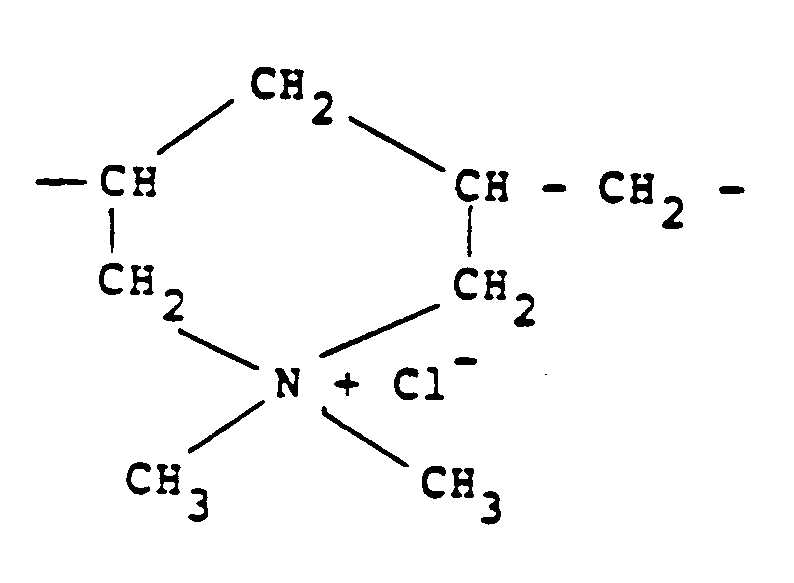
besitzt.
besitzt.
9. Verfahren nach einem der Ansprüche 1 bis 4, bei dem das kationische Polymer abgeleitet
ist von einem ungesättigten Polymer mit der Formel:

in der Z und Z', die gleich oder verschieden sein können, -CH₂CH=CHCH₂- oder -CH₂-CHOHCH₂- sind, Y und Y', die gleich oder verschieden sein können, entweder X oder -NH'R'' sind, X ein Halogen mit einem Atomgewicht von mehr als 30 ist, n eine ganze Zahl von 2 bis 20 ist und R' und R'' (I) gleiche oder verschiedene Alkylgruppen mit 1 bis 18 Kohlenstoffatomen gegebenenfalls substituiert mit 1 bis 2 Hydroxylgruppen sind oder (II) zusammen mit N einen gesättigten oder ungesättigten Ring mit 5 bis 7 Atomen bedeuten oder (III) zusammen mit N und einem Sauerstoffatom eine N-Morpholingruppe bedeuten.
in der Z und Z', die gleich oder verschieden sein können, -CH₂CH=CHCH₂- oder -CH₂-CHOHCH₂- sind, Y und Y', die gleich oder verschieden sein können, entweder X oder -NH'R'' sind, X ein Halogen mit einem Atomgewicht von mehr als 30 ist, n eine ganze Zahl von 2 bis 20 ist und R' und R'' (I) gleiche oder verschiedene Alkylgruppen mit 1 bis 18 Kohlenstoffatomen gegebenenfalls substituiert mit 1 bis 2 Hydroxylgruppen sind oder (II) zusammen mit N einen gesättigten oder ungesättigten Ring mit 5 bis 7 Atomen bedeuten oder (III) zusammen mit N und einem Sauerstoffatom eine N-Morpholingruppe bedeuten.
10. Verfahren nach einem der Ansprüche 1 bis 4, bei dem das kationische Polymer Poly(dimethylbutenyl)ammoniumchlorid-
bis-(triethanolammoniumchlorid) ist.
11. Verfahren nach einem der Ansprüche 1 bis 4, bei dem das kationische Polymer wiederkehrende
Einheiten der Formel:

besitzt, in der R eine niederen Alkylrest bedeutet.
besitzt, in der R eine niederen Alkylrest bedeutet.
12. Verfahren nach einem der Ansprüche 1 bis 4, bei dem das kationische Polymer die Formel:

besitzt, in der N 0 bis 500 ist.
besitzt, in der N 0 bis 500 ist.
13. Verfahren nach einem der Ansprüche 1 bis 4, bei dem das kationische Polymer ein kationisches
Tanninderivat ist, das durch Reaktion von Tannin mit Formaldehyd und einem Amin erhalten
worden ist.
14. Verfahren nach einem der vorangehenden Ansprüche, bei dem kationisches Polymer und
Salz jeweils in einer Menge von 1 bis 50 ppm vorhanden sind.
15. Verfahren nach Anspruch 14, bei dem kationisches Polymer und Salz jeweils in einer
Menge von 3 bis 10 ppm vorhanden sind.
16. Verfahren nach einem der vorangehenden Ansprüche, bei dem die relative Menge des Polymeren
und des Salzes bezogen auf das Gewicht 1:10 bis 10:1 ist.
17. Verfahren nach einem der vorangehenden Ansprüche, bei dem die Konzentration an Polymer
mindestens so groß wie die des Salzes ist.
18. Verfahren nach einem der vorangehenden Ansprüche, bei dem das wäßrige System ein Kühlsystem
ist.
19. Für die Zugabe zu einem wäßrigen System geeignete Zusammensetzung, dadurch gekennzeichnet, daß sie ein protoniertes oder quaternäres Ammonium-kationisches Polymer mit einem
Molekulargewicht von 400 bis 10 000 und mindestens ein wasserlösliches korrosionsverhinderndes
Salz enthält, das in der Lage ist, einen passivierenden Film auf der Anode zu bilden,
und bei dem es sich um ein Orthophosphat oder Nitrit handelt.
20. Zusammensetzung nach Anspruch 19, die in Form einer wäßrigen Lösung vorliegt.
21. Zusammensetzung nach Anspruch 19 oder 20, in der die aktiven Bestandteile (fest) in
einer Menge von 1 bis 25 Gew.-% vorhanden sind.
22. Zusammensetzung nach einem der Ansprüche 19 bis 21, bei der das Salz kein Ammoniumsalz
ist.
23. Zusammensetzung nach einem der Ansprüche 19 bis 22, bei der das Salz ein Alkalimetallsalz
ist.
24. Zusammensetzung nach einem der Ansprüche 19 bis 23, bei der das Salz Dinatrium- oder
Trinatriumorthophosphat oder Natriumnitrit ist.
25. Zusammensetzung nach einem der Ansprüche 19 bis 24, bei der das Polymer im wesentlichen
linear ist.
26. Zusammensetzung nach einem der Ansprüche 19 bis 25, bei der das Polymer von einem
ethylenisch ungesättigten Monomer, das eine quaternäre Ammoniumgruppe enthält, abgeleitet
ist oder durch Reaktion zwischen einem Polyalkylen und Epichlorhydrin oder durch Reaktion
zwischen Epichlorhydrin, Dimethylamin oder Ethylendiamin oder einem Polyalkylenpolyamin
erhalten worden ist.
27. Zusammensetzung nach einem der Ansprüche 19 bis 25, bei der das kationische Polymer
abgeleitet ist von Vinylpyridin oder Vinylimidazol oder einem Acrylderivat quaternisiert
mit C₁-C₁₈-Alkylhalogenid oder einem Benzylhalogenid oder Dimethyl- oder Diethylsulfat,
einem Vinylbenzylchlorid quaternisiert mit einem tertiären Amin oder einer Allylverbindung.
28. Zusammensetzung nach einem der Ansprüche 19 bis 25, bei der das kationische Polymer
10 bis 100 Mol.-% wiederkehrende Einheiten der Formel:
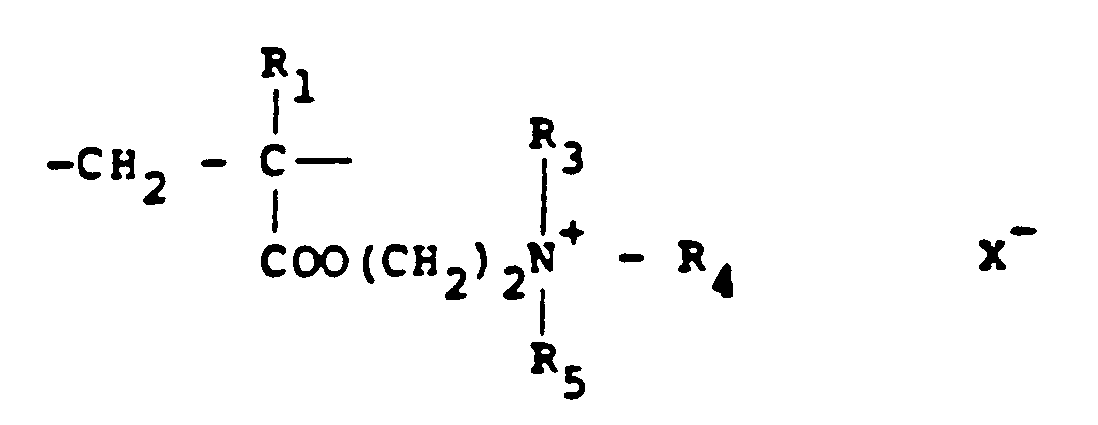
und 0 bis 90 Mol.-% wiederkehrende Einheiten der Formel:
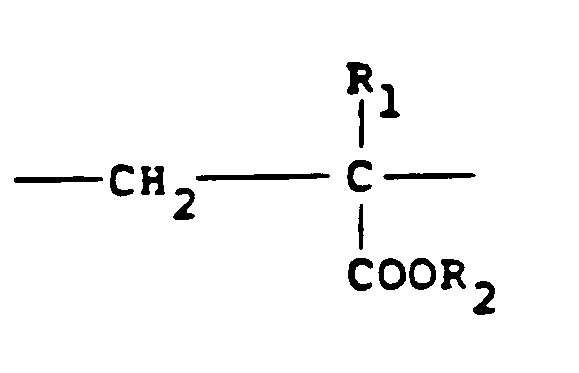
enthält, wobei R₁ Wasserstoff oder einen niederen Alkylrest bedeutet, R₂ eine langkettige Alkylgruppe bedeutet, R₃, R₄ und R₅ unabhängig Wasserstoff oder eine niedere Alkylgruppe bedeuten und X ein Anion bedeutet.
und 0 bis 90 Mol.-% wiederkehrende Einheiten der Formel:
enthält, wobei R₁ Wasserstoff oder einen niederen Alkylrest bedeutet, R₂ eine langkettige Alkylgruppe bedeutet, R₃, R₄ und R₅ unabhängig Wasserstoff oder eine niedere Alkylgruppe bedeuten und X ein Anion bedeutet.
29. Zusammensetzung nach einem der Ansprüche 19 bis 25, bei der das Polymer wiederkehrende
Einheiten der Formel:
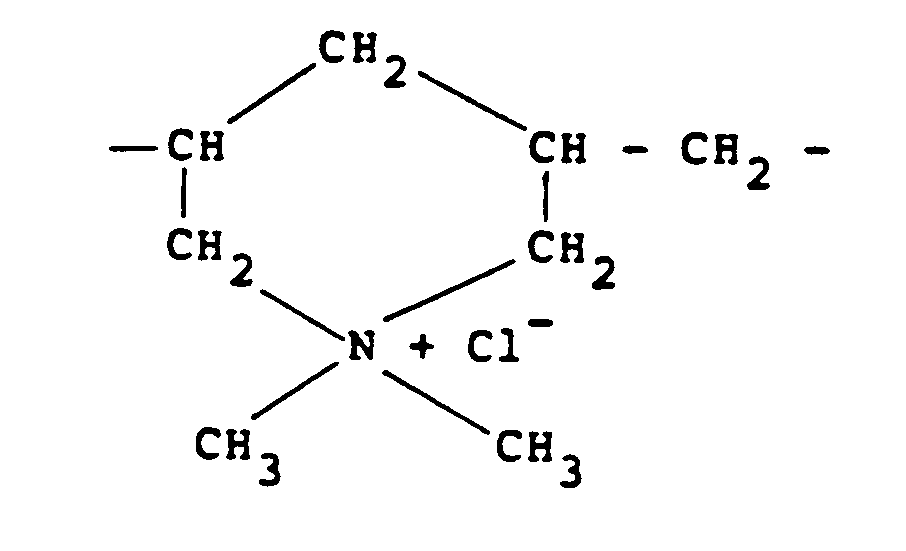
besitzt.
besitzt.
30. Zusammensetzung nach einem der Ansprüche 19 bis 25, bei der das kationische Polymer
abgeleitet ist von einem ungesättigten Polymer mit der Formel:

in der Z und Z', die gleich oder verschieden sein können, -CH₂CH=CHCH₂- oder -CH₂-CHOHCH₂- sind, Y und Y', die gleich oder verschieden sein können, entweder X oder -NH'R'' sind, X ein Halogen mit einem Atomgewicht von mehr als 30 ist, n eine ganze Zahl von 2 bis 20 ist und R' und R'' (I) gleiche oder verschiedene Alkylgruppen mit 1 bis 18 Kohlenstoffatomen gegebenenfalls substituiert mit 1 bis 2 Hydroxylgruppen sind oder (II) zusammen mit N einen gesättigten oder ungesättigten Ring mit 5 bis 7 Atomen bedeuten oder (III) zusammen mit N und einem Sauerstoffatom eine N-Morpholingruppe bedeuten.
in der Z und Z', die gleich oder verschieden sein können, -CH₂CH=CHCH₂- oder -CH₂-CHOHCH₂- sind, Y und Y', die gleich oder verschieden sein können, entweder X oder -NH'R'' sind, X ein Halogen mit einem Atomgewicht von mehr als 30 ist, n eine ganze Zahl von 2 bis 20 ist und R' und R'' (I) gleiche oder verschiedene Alkylgruppen mit 1 bis 18 Kohlenstoffatomen gegebenenfalls substituiert mit 1 bis 2 Hydroxylgruppen sind oder (II) zusammen mit N einen gesättigten oder ungesättigten Ring mit 5 bis 7 Atomen bedeuten oder (III) zusammen mit N und einem Sauerstoffatom eine N-Morpholingruppe bedeuten.
31. Zusammensetzung nach einem der Ansprüche 19 bis 25, bei der das kationische Polymer
Poly(dimethylbutenyl)ammoniumchlorid-bis-(triethanolammoniumchlorid) ist.
32. Zusammensetzung nach einem der Ansprüche 19 bis 25, bei der das kationische Polymer
wiederkehrende Einheiten der Formel:
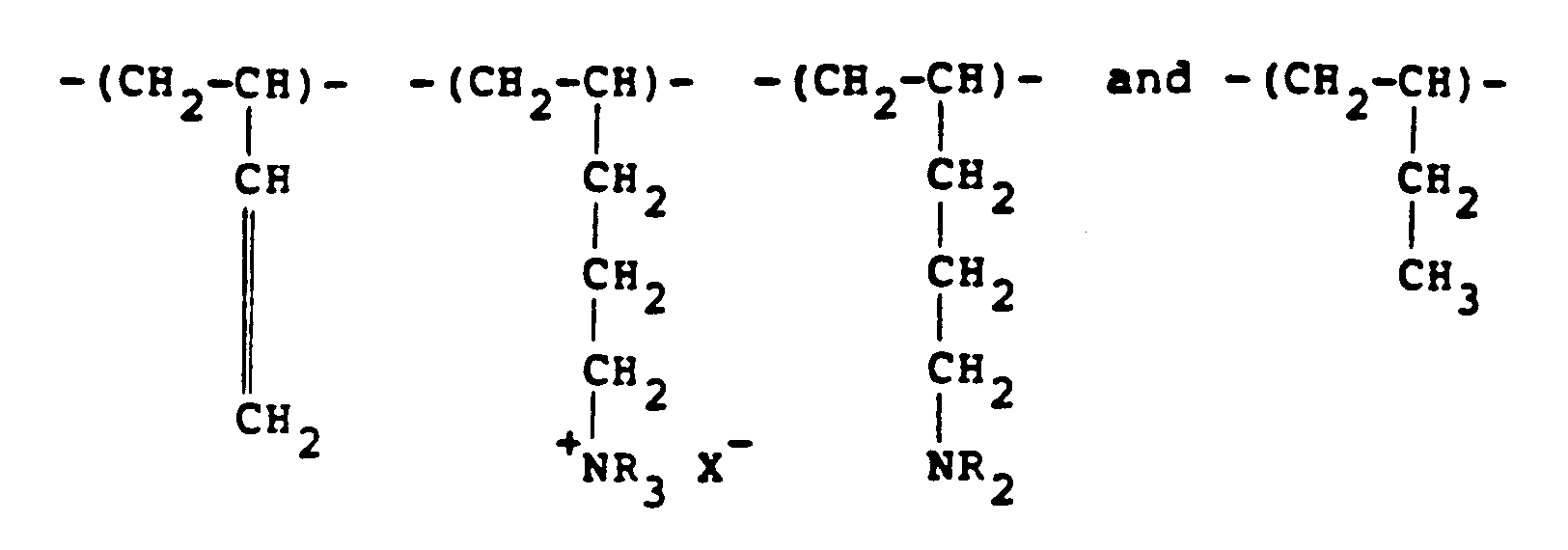
in den molaren Anteilen a:b₁:b₂:c besitzt, wobei R einen niederen Alkylrest bedeutet.
in den molaren Anteilen a:b₁:b₂:c besitzt, wobei R einen niederen Alkylrest bedeutet.
33. Zusammensetzung nach einem der Ansprüche 19 bis 25, bei der das kationische Polymer
die Formel:

besitzt, in der N 0 bis 500 ist.
besitzt, in der N 0 bis 500 ist.
34. Zusammensetzung nach einem der Ansprüche 19 bis 25, bei der das kationische Polymer
ein kationisches Tanninderivat ist, das durch Reaktion von Tannin mit Formaldehyd
und Amin erhalten worden ist.
35. Zusammensetzung nach einem der Ansprüche 19 bis 34, bei der die relativen Mengen der
beiden Komponenten bezogen auf das Gewicht 1:10 bis 10:1 betragen.
36. Zusammensetzung nach einem der Ansprüche 19 bis 35, bei der die Konzentration an Polymer
mindestens so groß wie die des Salzes ist.
37. Zusammensetzung nach einem der Ansprüche 19 bis 36, die außerdem ein Phosphonat enthält,
das sich nicht anodisch verhält, ein Dispersionsmittel, ein Azol oder ein Biozid enthält.
38. Zusammensetzung nach Anspruch 37, bei der das Phosphonat Pentaphosphonmethylen-substituiertes
Diethylentriamin ist, das Dispersionsmittel ein Copolymer von Maleinsäure und sulfoniertem
Styrol oder von Methacrylsäure und 2-Acrylamid-2-methylpropansulfonsäure ist, das
Azol Benzotriazol ist und das Biozid ein Isothiazolon, Methylen-bis(thiocyanat), eine
quaternäre Ammoniumverbindung oder ein Chlor freisetzendes Mittel ist.
